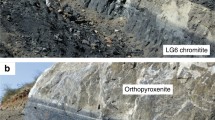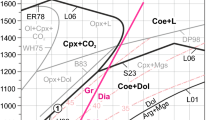Abstract
Reactions between a boninitic or basaltic magma and harzburgite at shallow mantle depths are thought to be closely related to the formation of podiform chromitites, but little experimental data is available on these reactions. In this study, a series of experiments were conducted at 1.5 GPa and 1 000–1 400 °C to investigate the interactions between boninitic magma and harzburgite in homogenous mixed systems with varied bulk concentrations of water (∼0.7 wt.%–10 wt.%) and Cr2O3 (∼0.2 wt.%–4 wt.%). In the experimental charges, chromite grains can be observed coexisting with orthopyroxene, clinopyroxene±olivine, and quenched melt in the Cr-bearing systems. The bulk concentration of Cr2O3 in the starting material has a slight effect on compositional changes in the chromites generated. However, the Cr# (Cr#=100×Cr/(Cr+Al)) and Mg# (Mg#=100×Mg/(Mg+Fe)) values for the chromites exhibit positive and negative correlations, respectively, with the bulk H2O concentrations. At 1 100 °C, chromite Cr# values range from ∼33–35 to ∼58–65, and chromite Mg# values range from ∼70–73 to ∼55–58 when bulk H2O contents in the starting material are increased from ∼0.7 wt.% to ∼10 wt.%. The experimentally produced chromites have compositions (as expressed by Cr#, Mg#, and NiO and MnO contents) similar to natural chromites from low-Cr# chromitite bodies. We suggest that the interactions between boninitic magmas with varied H2O contents and harzburgite in a shallow mantle wedge could be a possible mechanism that forms the low-Cr# chromitites found in ophiolites. We emphasize here that H2O may play an important role in the compositional evolutions of natural chromitites.
Similar content being viewed by others
References Cited
Ahmed, A., Arai, S., 2002. Unexpectedly High-PGE Chromitite from the Deeper Mantle Section of the Northern Oman Ophiolite and Its Tectonic Implications. Contributions to Mineralogy and Petrology, 143(3): 263–278. https://doi.org/10.1007/s00410-002-0347-8
Arai, S., 1997. Origin of Podiform Chromitites. Journal of Asian Earth Sciences, 15(2/3): 303–310. https://doi.org/10.1016/S0743-9547(97)00015-9
Arai, S., Matsukage, K., 1998. Petrology of a Chromitite Micropod from Hess Deep, Equatorial Pacific: A Comparison between Abyssal and Alpine-Type Podiform Chromitites. Lithos, 43(1): 1–14. https://doi.org/10.1016/s0024-4937(98)00003-6
Arai, S., Miura, M., 2016. Formation and Modification of Chromitites in the Mantle. Lithos, 264: 277–295. https://doi.org/10.1016/j.lithos.2016.08.039
Arai, S., Yurimoto, H., 1994. Podiform Chromitites of the Tari-Misaka Ultramafic Complex, Southwestern Japan, as Mantle-Melt Interaction Products. Economic Geology, 89(6): 1279–1288. https://doi.org/10.2113/gsecongeo.89.6.1279
Bonavia, F. F., Diella, V., Ferrario, A., 1993. Precambrian Podiform Chromitites from Kenticha Hill, Southern Ethiopia. Economic Geology, 88(1): 198–202. https://doi.org/10.2113/gsecongeo.88.L198
Dickey, J. S., 1975. A Hypothesis of Origin for Podiform Chromite Deposits. Geochimica et Cosmochimica Acta, 39(6): 1061–1074. https://doi.org/10.1016/0016-7037(75)90047-2
Edwards, S. J., Pearce, J. A., Freeman, J., 2000. New Insights Concerning the Influence of Water during the Formation of Podiform Chromitite. Special Papers-Geololgical Society of America, 139–148
Gaetani, G. A., Grove, T. L., Bryan, W. B., 1994. Experimental Phase Relations of Basaltic Andesite from Hole 839B under Hydrous and Anhydrous Conditions. In Proceedings of the Ocean Drilling Program, Scientific Results, 135: 557–563
Gervilla, F., Proenza, J. A., Frei, R., et al., 2005. Distribution of Platinum-Group Elements and Os Isotopes in Chromite Ores from Mayarí-Baracoa Ophiolitic Belt (eastern Cuba). Contributions to Mineralogy and Petrology, 150(6): 589–607. https://doi.org/10.1007/s00410-005-0039-2
González-Jiménez, J. M., Proenza, J. A., Gervilla, F., et al., 2011. High-Cr and High-Al Chromitites from the Sagua de Tánamo District, Mayarí-Cristal Ophiolitic Massif (Eastern Cuba): Constraints on Their Origin from Mineralogy and Geochemistry of Chromian Spinel and Platinum-Group Elements. Lithos, 125(1/2): 101–121. https://doi.org/10.1016/j.lithos.2011.01.016
Graham, I. T., Franklin, B. J., Marshall, B., 1996. Chemistry and Mineralogy of Podiform Chromitite Deposits, Southern NSW, Australia: A Guide to Their Origin and Evolution. Mineralogy and Petrology, 57(3/4): 129–150. https://doi.org/10.1007/bf01162355
Griffin, W. L., Afonso, J. C., Belousova, E. A., et al., 2016. Mantle Recycling: Transition Zone Metamorphism of Tibetan Ophiolitic Peridotites and Its Tectonic Implications. Journal of Petrology, 57(4): 655–684. https://doi.org/10.1093/petrology/egw011
Hock, M., Friedrich, G., Plüger, W. L., et al., 1986. Refractory- and Metallurgical-Type Chromite Ores, Zambales Ophiolite, Luzon, Philippines. Mineralium Deposita, 21(3): 190–199. https://doi.org/10.1007/bf00199799
Johan, Z., Martin, R. F., Ettler, V., 2017. Fluids are Bound to be Involved in the Formation of Ophiolitic Chromite Deposits. European Journal of Mineralogy, 29(4): 543–555. https://doi.org/10.1127/ejm/2017/0029-2648
Leblanc, M., 1997. Chromitite and Ultramafic Rock Compositional Zoning through a Paleotransform Fault, Poum, New Caledonia: Reply. Economic Geology, 92(4): 503–504. https://doi.org/10.2113/gsecongeo.92.4.503
Leblanc, M., Violette, J. F., 1983. Distribution of Aluminum-Rich and Chromium-Rich Chromite Pods in Ophiolite Peridotites. Economic Geology, 78(2): 293–301. https://doi.org/10.2113/gsecongeo.78.2.293
Matveev, S., Ballhaus, C., 2002. Role of Water in the Origin of Podiform Chromitite Deposits. Earth and Planetary Science Letters, 203(1): 235–243. https://doi.org/10.1016/s0012-821x(02)00860-9
Melcher, F., Grum, W., Simon, G., et al., 1997. Petrogenesis of the Ophiolitic Giant Chromite Deposits of Kempirsai, Kazakhstan: A Study of Solid and Fluid Inclusions in Chromite. Journal of Petrology, 38(10): 1419–1458. https://doi.org/10.1093/petroj/38.10.1419
Moghadam, H. S., Zaki Khedr, M., Arai, S., et al., 2015. Arc-Related Harzburgite-Dunite-Chromitite Complexes in the Mantle Section of the Sabzevar Ophiolite, Iran: A Model for Formation of Podiform Chromitites. Gondwana Research, 27(2): 575–593. https://doi.org/10.1016/j.gr.2013.09.007
Morishita, T., Dilek, Y., Shallo, M., et al., 2011. Insight into the Uppermost Mantle Section of a Maturing Arc: The Eastern Mirdita Ophiolite, Albania. Lithos, 124(3/4): 215–226. https://doi.org/10.1016/j.lithos.2010.10.003
Nicolas, A., Al-Azri, H., 1991. Chromite-Rich and Chromite-Poor Ophiolites: The Oman Case. In Ophiolite Genesis and Evolution of the Oceanic Lithosphere. Springer, Dordrecht. 261–274. https://doi.org/10.1007/978-94-011-3358-6_14
Payot, B. D., Arai, S., Tamayo, R. A. Jr, et al., 2013. Textural Evidence for the Chromite-Oversaturated Character of the Melt Involved in Podiform Chromitite Formation. Resource Geology, 63(3): 313–319. https://doi.org/10.1111/rge.12011
Proenza, J. A., Zaccarini, F., Escayola, M., et al., 2008. Composition and Textures of Chromite and Platinum-Group Minerals in Chromitites of the Western Ophiolitic Belt from Pampean Ranges of Córdoba, Argentina. Ore Geology Reviews, 33(1): 32–48. https://doi.org/10.1016/j.oregeorev.2006.05.009
Proenza, J., Gervilla, F., Melgarejo, J., et al., 1999. Al- and Cr-Rich Chromitites from the Mayari-Baracoa Ophiolitic Belt (Eastern Cuba); Consequence of Interaction between Volatile-Rich Melts and Peridotites in Suprasubduction Mantle. Economic Geology, 94(4): 547–566. https://doi.org/10.2113/gsecongeo.94.4.547
Robinson, P., Trumbull, R. B., Schmitt, A., et al., 2015. The Origin and Significance of Crustal Minerals in Ophiolitic Chromitites and Peridotites. Gondwana Research, 27: 486–506. https://doi.org/10.1016/j.gr.2014.06.003
Rollinson, H., 2008. The Geochemistry of Mantle Chromitites from the Northern Part of the Oman Ophiolite: Inferred Parental Melt Compositions. Contributions to Mineralogy and Petrology, 156(3): 273–288. https://doi.org/10.1007/s00410-008-0284-2
Rollinson, H., Adetunji, J., 2013. Mantle Podiform Chromitites do not Form beneath Mid-Ocean Ridges: A Case Study from the Moho Transition Zone of the Oman Ophiolite. Lithos, 177: 314–327. https://doi.org/10.1016/j.lithos.2013.07.004
Rui, H. C., Jiao, J. G., Xia, M. Z., et al., 2019. Origin of Chromitites in the Songshugou Peridotite Massif, Qinling Orogen (Central China): Mineralogical and Geochemical Evidence. Journal of Earth Science, 30(3): 476–493. https://doi.org/10.1007/s12583-019-1227-8
Schiano, P., Clocchiatti, R., Lorand, J. P., et al., 1997. Primitive Basaltic Melts Included in Podiform Chromites from the Oman Ophiolite. Earth and Planetary Science Letters, 146(3/4): 489–497. https://doi.org/10.1016/s0012-821x(96)00254-3
Shi, R. D., Alard, O., Zhi, X. C., et al., 2007. Multiple Events in the Neo-Tethyan Oceanic Upper Mantle: Evidence from Ru-Os-Ir Alloys in the Luobusa and Dongqiao Ophiolitic Podiform Chromitites, Tibet. Earth and Planetary Science Letters, 261(1/2): 33–48. https://doi.org/10.1016/j.epsl.2007.05.044
Shi, R. D., Griffin, W. L., O’Reilly, S. Y., et al., 2012. Melt/mantle Mixing Produces Podiform Chromite Deposits in Ophiolites: Implications of Re-Os Systematics in the Dongqiao Neo-Tethyan Ophiolite, Northern Tibet. Gondwana Research, 21(1): 194–206. https://doi.org/10.1016/j.gr.2011.05.011
Thayer, T. P., 1964. Principal Features and Origin of Podiform Chromite Deposits, and Some Observations on the Guelman-Soridag District, Turkey. Economic Geology, 59(8): 1497–1524. https://doi.org/10.2113/gsecongeo.59.8.1497
Uysal, İ., Tarkian, M., Sadiklar, M. B., et al., 2009. Petrology of Al- and Cr-Rich Ophiolitic Chromitites from the Mugla, SW Turkey: Implications from Composition of Chromite, Solid Inclusions of Platinum-Group Mineral, Silicate, and Base-Metal Mineral, and Os-Isotope Geochemistry. Contributions to Mineralogy and Petrology, 158(5): 659–674. https://doi.org/10.1007/s00410-009-0402-9
Wang, C., Jin, Z. M., Gao, S., et al., 2010. Eclogite-Melt/Peridotite Reaction: Experimental Constrains on the Destruction Mechanism of the North China Craton. Science China Earth Sciences, 53(6): 797–809. https://doi.org/10.1007/s11430-010-3084-2
Xiong, F. H., Yang, J. S., Dilek, Y., et al., 2018. Origin and Significance of Diamonds and other Exotic Minerals in the Dingqing Ophiolite Peridotites, Eastern Bangong-Nujiang Suture Zone, Tibet. Lithosphere, 10(1): 142–155. https://doi.org/10.1130/l607.1
Xiong, F. H., Yang, J. S., Robinson, P. T., et al., 2015. Origin of Podiform Chromitite, a New Model Based on the Luobusa Ophiolite, Tibet. Gondwana Research, 27(2): 525–542. https://doi.org/10.1016/j.gr.2014.04.008
Xiong, F. H., Yang, J. S., Robinson, P. T., et al., 2017a. High-Al and High-Cr Podiform Chromitites from the Western Yarlung-Zangbo Suture Zone, Tibet: Implications from Mineralogy and Geochemistry of Chromian Spinel, and Platinum-Group Elements. Ore Geology Reviews, 80: 1020–1041. https://doi.org/10.1016/j.oregeorev.2016.09.009
Xiong, F. H., Yang, J. S., Robinson, P. T., et al., 2017b. Petrology and Geochemistry of Peridotites and Podiform Chromitite in the Xigaze Ophiolite, Tibet: Implications for a Suprasubduction Zone Origin. Journal of Asian Earth Sciences, 146: 56–75. https://doi.org/10.1016/j.jseaes.2017.05.001
Xiong, Q., Henry, H., Griffin, W. L., et al., 2017. High- and Low-Cr Chromitite and Dunite in a Tibetan Ophiolite: Evolution from Mature Subduction System to Incipient Forearc in the Neo-Tethyan Ocean. Contributions to Mineralogy and Petrology, 172(6): 45. https://doi.org/10.1007/s00410-017-1364-y
Zaccarini, F., Garuti, G., Proenza, J. A., et al., 2011. Chromite and Platinum Group Elements Mineralization in the Santa Elena Ultramafic Nappe (Costa Rica): Geodynamic Implications. Geologica Acta: An International Earth Science Journal, 9(3/4): 407–423
Zhou, M. F., Robinson, P. T., 1997. Origin and Tectonic Environment of Podiform Chromite Deposits. Economic Geology, 92(2): 259–262. https://doi.org/10.2113/gsecongeo.92.2.259
Zhou, M. F., Robinson, P. T., Malpas, J., et al., 1996. Podiform Chromitites in the Luobusa Ophiolite (Southern Tibet): Implications for Melt-Rock Interaction and Chromite Segregation in the Upper Mantle. Journal of Petrology, 37(1): 3–21. https://doi.org/10.1093/petrology/37.1.3
Zhou, M. F., Robinson, P. T., Su, B. X., et al., 2014. Compositions of Chromite, Associated Minerals, and Parental Magmas of Podiform Chromite Deposits: The Role of Slab Contamination of Asthenospheric Melts in Suprasubduction Zone Environments. Gondwana Research, 26(1): 262–283. https://doi.org/10.1016/j.gr.2013.12.011
Zhou, M. F., Sun, M., Keays, R. R., et al., 1998. Controls on Platinum-Group Elemental Distributions of Podiform Chromitites: A Case Study of High-Cr and High-Al Chromitites from Chinese Orogenic Belts. Geochimica et Cosmochimica Acta, 62(4): 677–688. https://doi.org/10.1016/s0016-7037(97)00382-7
Acknowledgments
This study was supported by the National Programme on Global Change and Air-Sea Interaction (No. GASI-GEOGE-02), the National Nature Science Foundation of China (Nos. 41772040, 91858104) and the Fundamental Research Funds for the Central Universities, Hohai University (No. 2013/B18020030). We thank Zhong Gao and Biji Luo for providing the natural boninite sample (QL-Bon), and Jihao Zhu and Jianggu Lu for technical support during EPMA analysis. We acknowledge the use of EPMA in the Key Laboratory of Submarine Geosciences, State Oceanic Administration. We thank Junlong Yang, Xiangfa Wang and Xingdong Zhou for technical support during high-pressure experiments. The final publication is available at Springer via https://doi.org/10.1007/s12583-020-1291-0.
Author information
Authors and Affiliations
Corresponding author
Rights and permissions
About this article
Cite this article
Zhao, Y., Zhang, Y., Wang, C. et al. Experimental Constraints on Formation of Low-Cr# Chromitite: Effect of Variable H2O and Cr2O3 on Boninitic-Magma and Harzburgite Reactions. J. Earth Sci. 31, 709–722 (2020). https://doi.org/10.1007/s12583-020-1291-0
Received:
Accepted:
Published:
Issue Date:
DOI: https://doi.org/10.1007/s12583-020-1291-0




